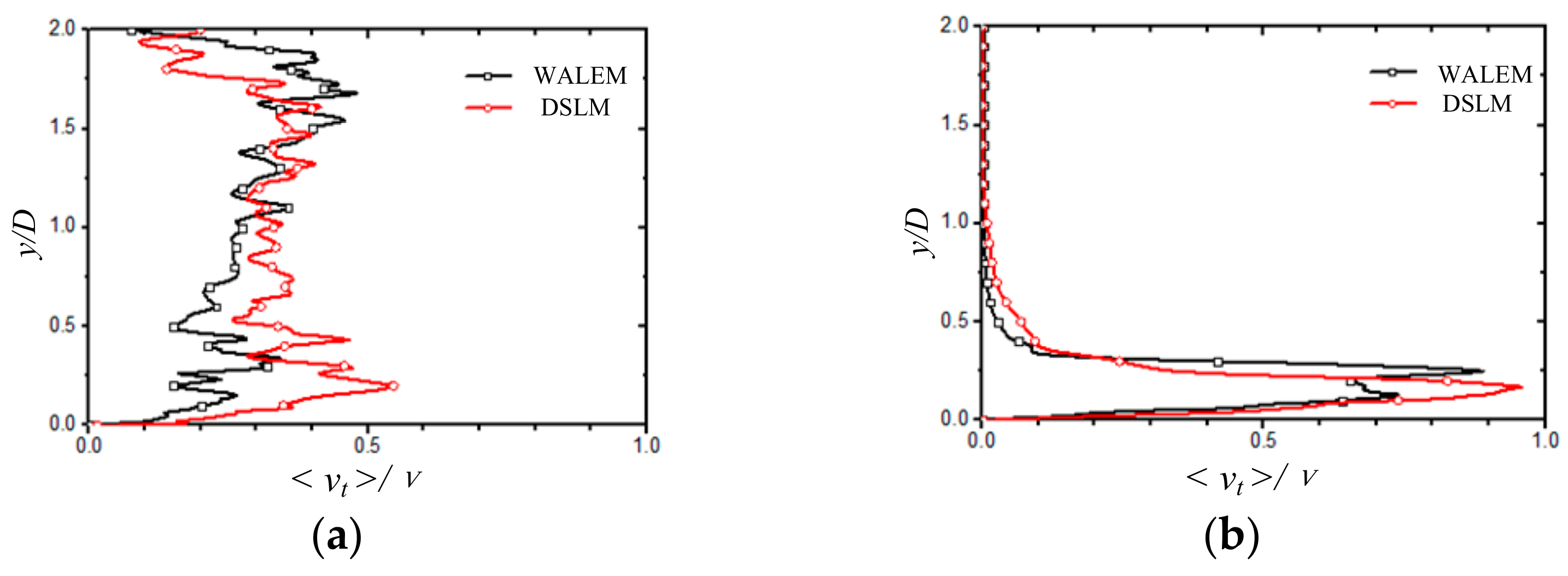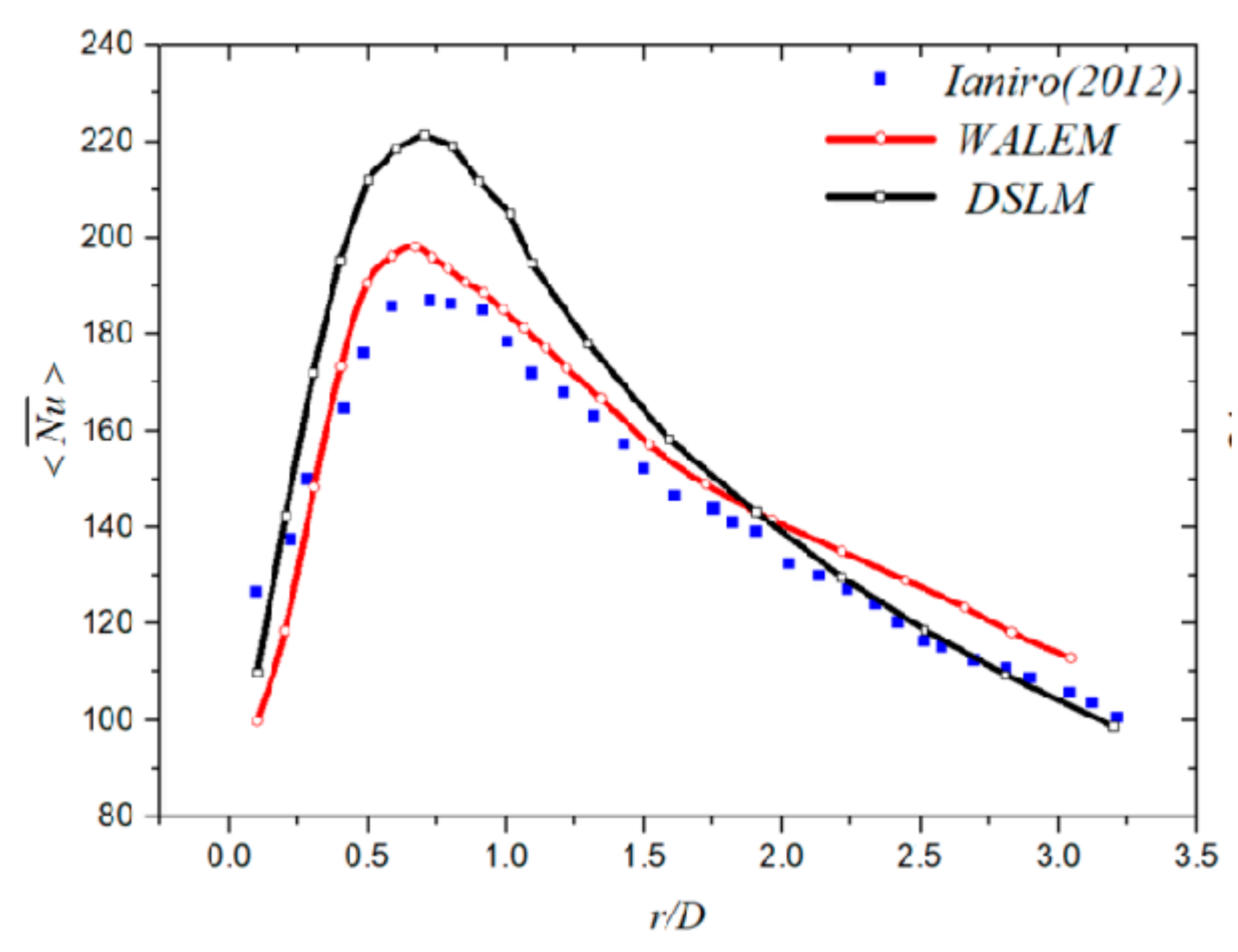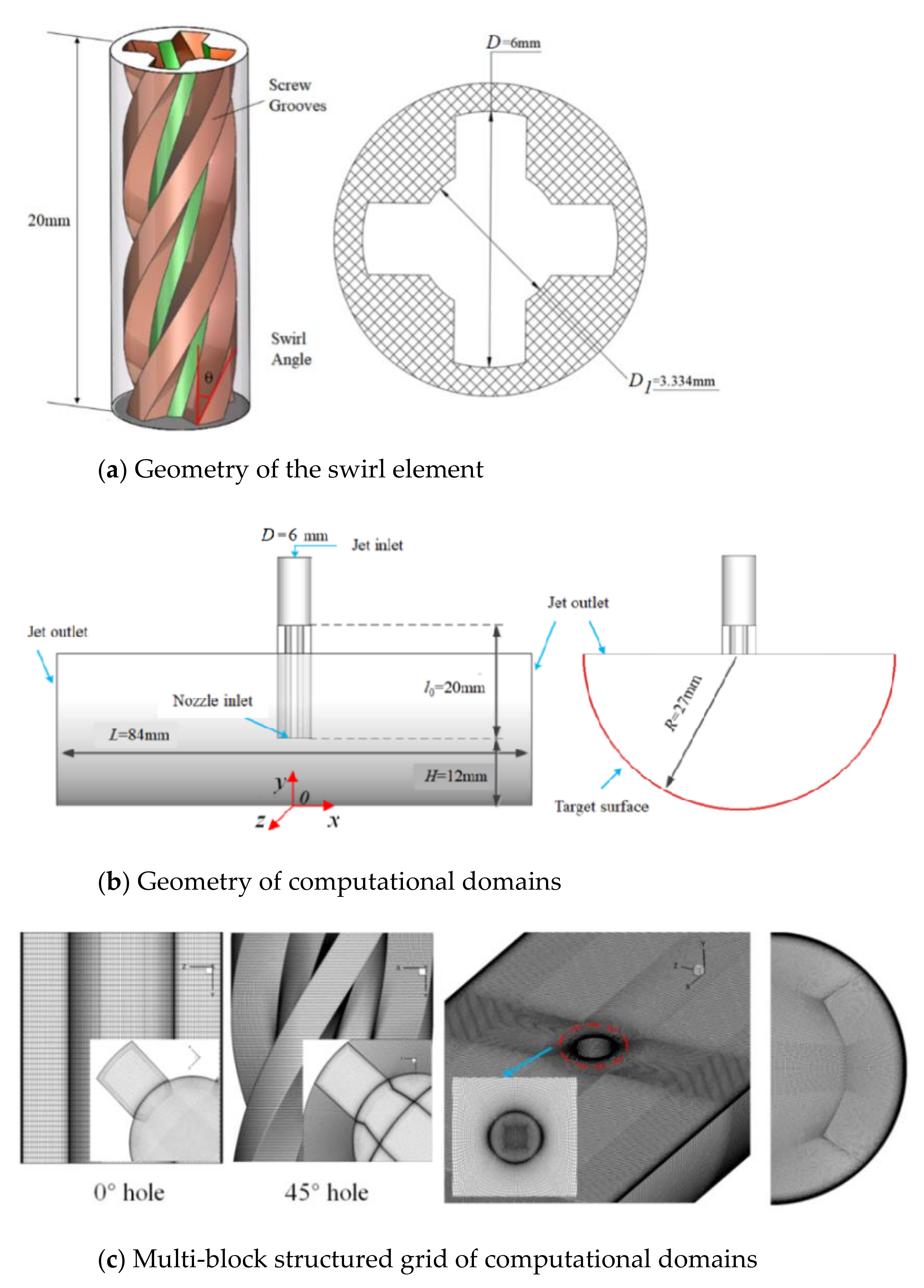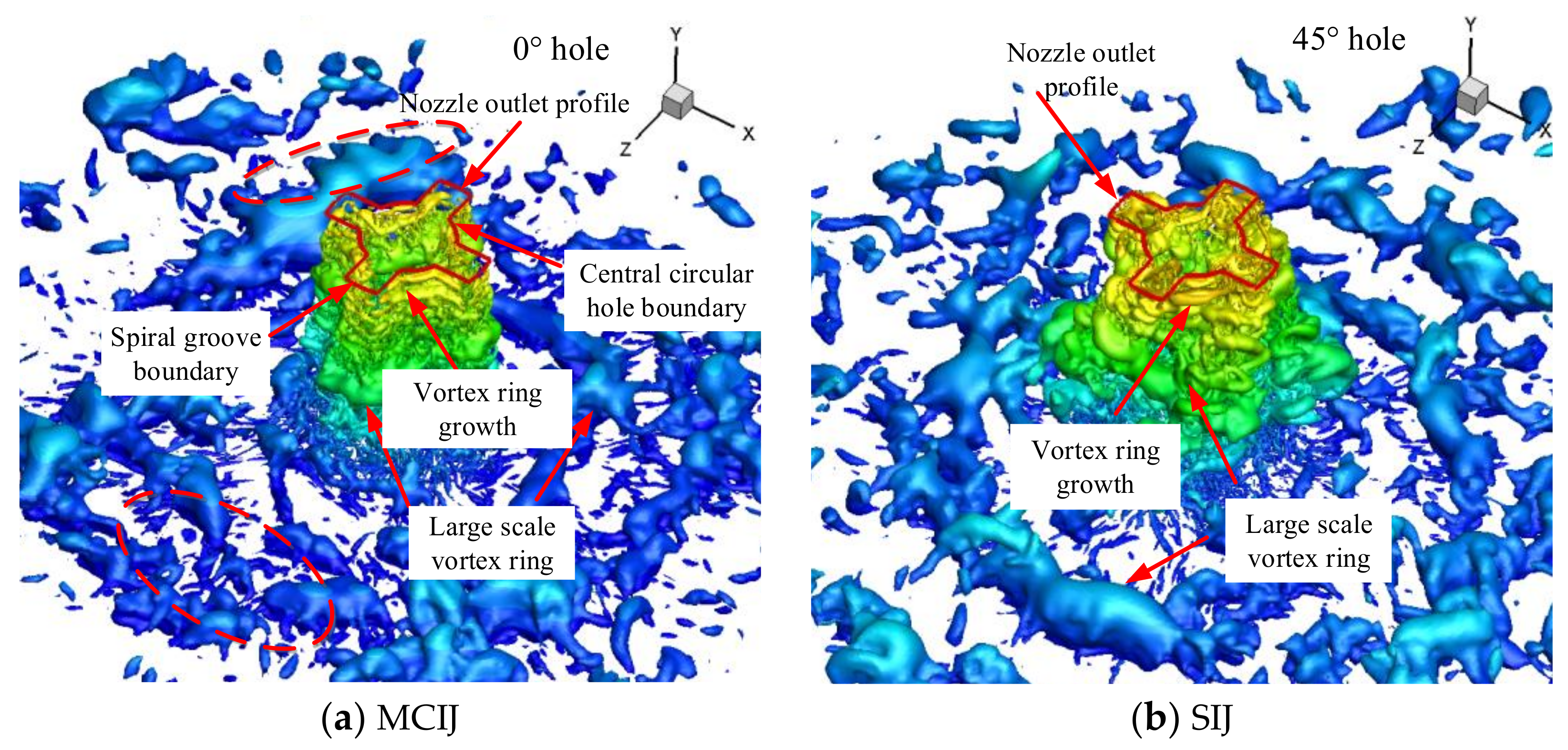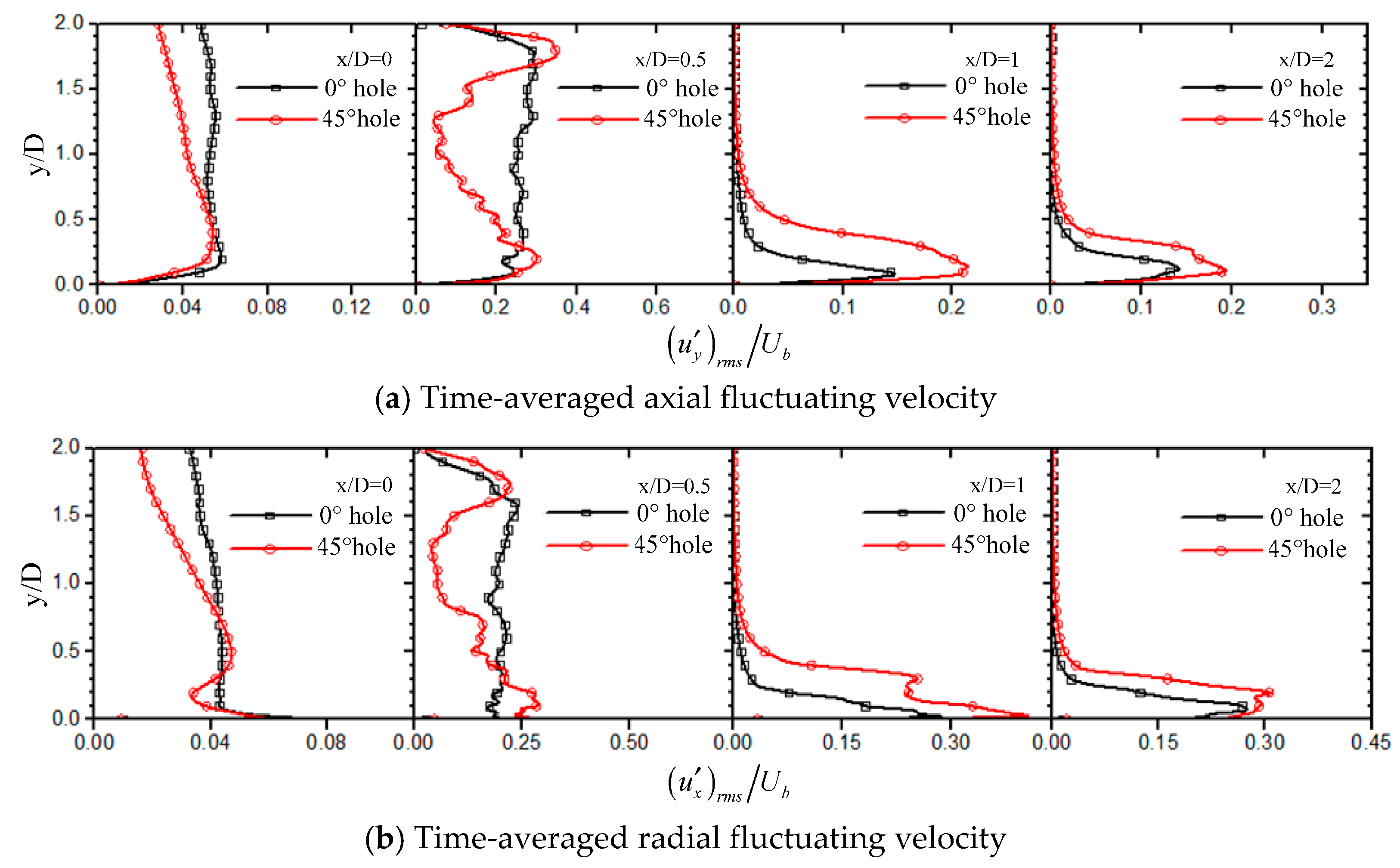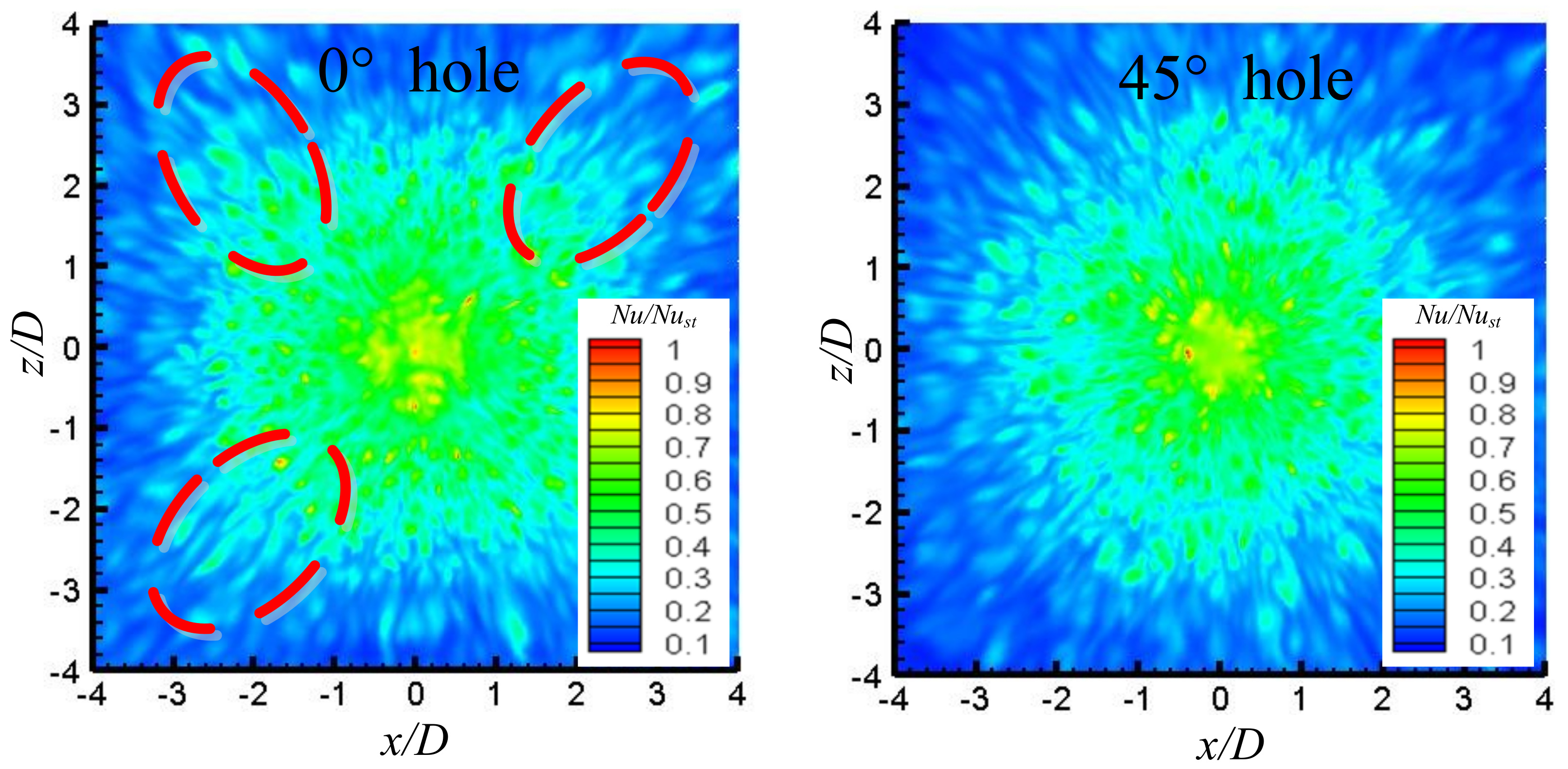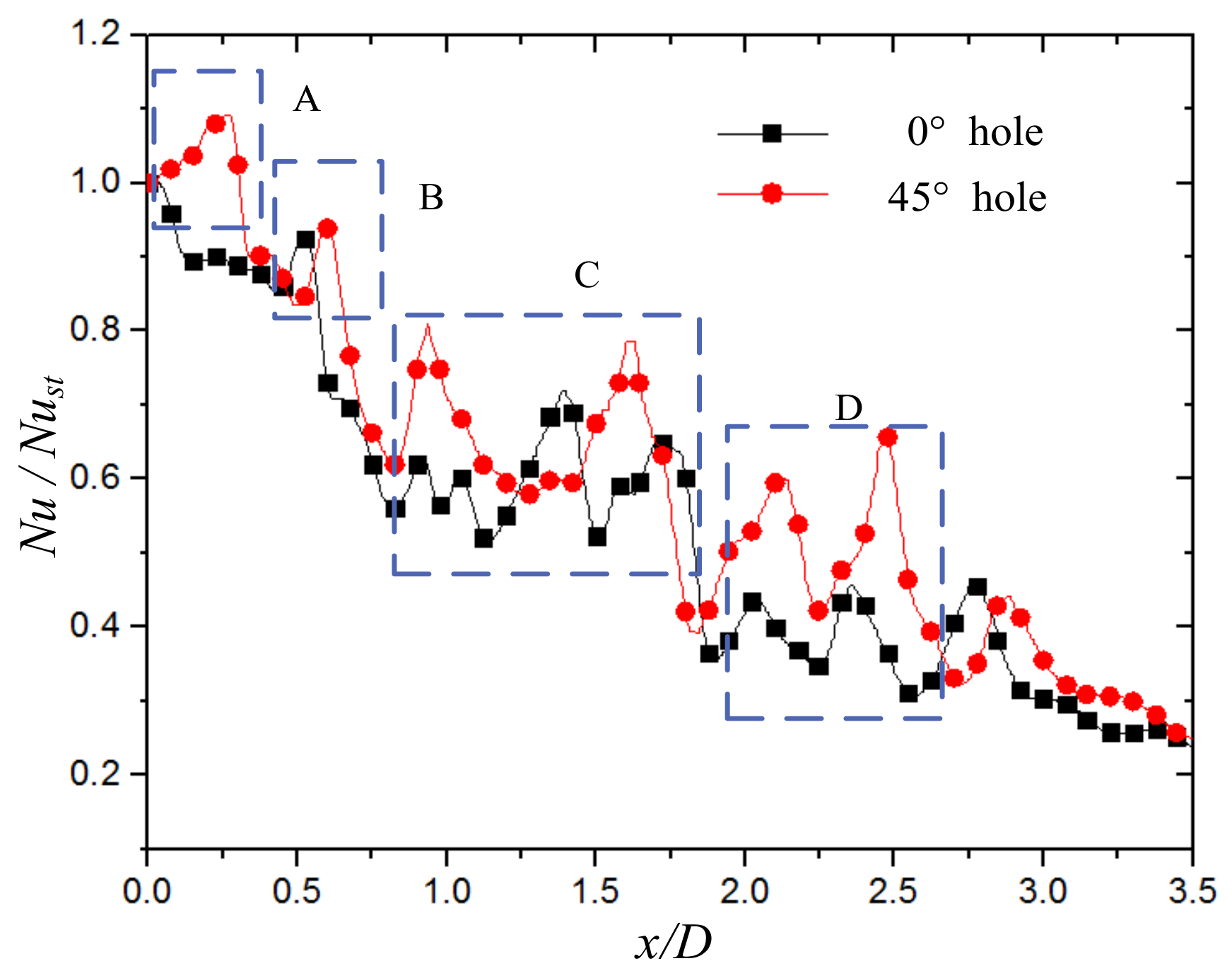4.1. Flow Field Analysis
Figure 6 shows the contours of the instantaneous axial velocity in non-swirling and swirling turbulent impinging jets in the XOY and YOZ planes. Compared with the MCIJ, SIJ has a larger obstruction effect on the jet flow due to the spiral channels. Most of the jet is collected in the central region of the nozzle, resulting in a larger axial velocity of the potential flow core in the jet space for the 45° spiral nozzle. Due to the effect of the swirl on the jets, it can also be seen that SIJ has a large tangential velocity and the effect to entrain the surrounding low-speed airflow is stronger, while the entraining airflow from the top of the jet space is higher. Under the action of the processing vortices, the entraining airflow is rapidly mixed with the potential flow, so that the jet with high speed under the nozzle exit, the blue region shown in
Figure 6b, becomes gradually weak, which decays more rapidly along the flow direction. At the periphery of the potential flow, the mixed airflow forms the “skirt type” green region with a larger diffusion area. For the MCIJ issuing from the 0° straight nozzle, the injected groove velocity is slightly lower than that at the central region of the nozzle due to the effect of the wall boundary layer, while it has a longer potential flow in the jet space and forms a “taper-foot-type” green region with a relatively smaller diffusion area compared with the SIJ. After the jet impacts the concave target, the rebound axial velocity from the wall free jet in the YOZ plane (
uy/
Ub = 0.8) is much larger than that in the XOY plane (
uy/
Ub = 0.3) due to flow delay on the curved surface for the MCIJ, while the rebound axial velocities in the XOY and YOZ planes (
uy/
Ub = 0.6) are comparable due to the entrainment effect of the velocity component of the swirl. Therefore, it can be inferred from the flow phenomenon that the swirl flow by the 45° spiral nozzle struggles more to escape from the curved and flat surfaces. As a result, the cooling effect may be improved on the curved surface with a more uniform heat transfer. It is worth noting that the range of legend values in
Figure 6 is the actual range of solution values. Even though the color is the same, the value is not the same.
Figure 7 shows the distribution of pressure in the XOY and YOZ planes. For the MCIJ, there are a series of blue regions with negative pressure (marked in red circle) around the potential flow, which are generated from Kelvin–Helmholtz instability in the shear layer, resulting in a series of vortex pairs. Under the entrainment effect of the airflow in the free shear layer, the jet in the stagnation zone deflects quickly, escapes outward in the radial direction, forms wall free jet at about
x/D = 1 with the negative pressure in the blue region near the wall, and tends to gradually entrain the low-speed ambient gas above the wall. The secondary blue region near the wall occurs at
x/D = 1.8, where the escaped airflow with the dominant radial velocity meets with the entrained ambient gas from the outlet. For the SIJ, there are not any vortex pairs in the jet space, and many blue regions of high negative pressure with a small scale are distributed disorderly throughout the whole downstream flow of the nozzle. It indicates that the addition of tangential velocity resulted in a more complex entrainment mixing jet. Accordingly, many small-scale complex vortices form and distribute anywhere around the central-jet impinging zone. A peak of high negative pressure near the wall at
x/D = 0.8 can be seen in the XOY plane, which indicates that the wall-free jet at that position is more intense than that of the non-swirling jet. Compared with the MCIJ, the red region of high positive pressure in the stagnation zone for the SIJ is bigger, which is attributed to the potential flow in the central region developing closer to the target surface. It is worth noting that the range of legend values in
Figure 7 is the actual range of solution values. Even though the color is the same, the value is not the same.
Figure 8 shows the streamlines and velocity vectors in the XOY and YOZ planes. For the MCIJ, the surrounding airflow from the top of jet space is carried by the free shear layer, moving downstream to the target surface with some vortex pairs, and deflecting to the radial direction at
x/D = 0.5–0.8 with a similar corner vortex. When the jet impinges the stagnation point, the rebounded airflow near the wall also deflects to the radial direction and meets the shear tangential flow (marked red curves), which results in a large-scale recirculation vortex at about
x/D = 1 in the XOY plane. A similar vortex occurs at
z/D = 1.25 in the YOZ plane due to the hamper effect of the curved cylinder concave target on the rebounded tangential airflow. It should be noted that the recirculation vortices produce a certain suppression on the deflected airflow in the stagnation zone to escape along the radial direction, which would weaken the heat transfer in this region to some extent. In the range of
x/D = 1–1.5, the escaped velocity near the wall gradually increases and the entrainment effect of shear flow above the wall also gradually enhances. In the range of
x/D = 1.5 away from the stagnation point, the escaped airflow near the wall would hold steady. However, shear flow meets the entrained airflow from the outlet, resulting in a large-scale recirculation vortex at
x/D = 2.3 near the exit of jet space. Indeed, the discharge capacity of axial flow along the wall would be suppressed by the vortex, and heat transfer would be the same. For the SIJ, the potential flow in the central region has a bigger axial velocity, and the airflow of the free shear layer around the potential flow has a stronger entrainment effect on the surrounding gas. It can be seen that lots of marked blue oblique curves of entrainment flow come from the top of jet space. Compared with the non-swirling case, these curves are denser without any large-scale vortex. At the same time, there is no obvious flow structure of vortex pairs around the potential flow, and no complicated similar corner vortex in the range of
x/D = 0.5–0.8 in the XOY plane. These disappeared large-scale vortices may be attributed to tangential velocity of the swirl jet. The escaped airflow near the wall in the XOY plane has a higher radial velocity, resulting in a stronger shear flow. It shows that the whole recirculation vortex appears earlier at
x/D = 2 and a large-scale semi-vortex follows downstream near the exit. Three obvious vortices above the concave wall form in the YOZ plane as shear flow meets with the entrained airflow from the top of jet space. It can be seen that the positions of vortex center are at
z/D = 0.7, 1.2, and 2.3 for the MCIJ, while these positions are at
z/D = 0.9, 1.8, and 2.3 for SIJ. Two upstream vortices for the SIJ are not only further from the stagnation point, but also higher above the wall compared with the MCIJ. Moreover, for the MCIJ, one more unformed recirculation vortex appears near the exit except three vortices. It should be pointed out that these different flow structures for the SIJ would be beneficial to improve heat transfer on the semi-cylinder concave surface.
Figure 9 shows the instantaneous Q-criterion. Jeong et al. [
28] proposed the Q-criterion based on the positive second invariant of velocity gradient or the complex eigenvalues of velocity gradient; their definition can accurately identify the vortex core in flows where the vortex geometry is intuitively clear. The value of
Q is the second invariant and is defined as
where
are the symmetric and antisymmetric components of velocity gradient, i.e.,
. Thus,
Q represents the local balance between shear strain rate and vorticity magnitude. Then,
Q is dimensionless as:
The flow in the free shear layer gradually forms lots of small-scale vortices, and some of these vortices develop, grow up, and come together, and at last the vortex rings form. The vortex ring may also continue growing and linking up into a large-scale vortex ring. For the MCIJ, small-scale vortex rings in the green region around the potential flow have a small diffusion area, and four large-scale blue vortex rings near the wall distribute in four directions, corresponding to the corners of four straight grooves. As the target is a semi-cylinder concave surface, the discharge capacity for the MCIJ is different. It can be seen that two of the four large-scale blue vortex rings are big, and the other two are small. Small-scale vortex rings are relatively sparse among these large vortex rings. For the SIJ, many moderate-scale vortex rings in the green region around the potential flow have a big diffusion area, and large-scale blue vortex rings near the wall evenly distribute and link into a circle. It can be inferred that the airflow near the wall escapes mainly along four corners for the MCIJ, while the airflow escapes evenly all around for the SIJ.
Jet flow enters the region of vortex agglomeration around a dimensionless height
y/D = 0.6–0.8, and then at the downstream area at about
y/D = 0.25, the escaped flow enters the region of vortex stretching and deformation near the target surface, and the large vortex ring appears.
Figure 10 shows the mean second invariant in the jet space at
y/D = 0.05 along the x direction. For the MCIJ, the connected vortices are prevalent in the range of
x/D = 0.5~1.5; two large vortex rings appear at the locations of
x/D = 0.7 and
x/D = 1.3. For the SIJ, only two large vortex rings appear at the locations of
x/D = 0.5 and
x/D = 1.3 due to the significant entrainment and aggregation effects for the swirling jet. Compared to the MCIJ, the first large vortex ring from the jet free shear layer has a bigger intensity, while the second large vortex covers a much wider area; hence, the unconnected vortex region occurs. There are several recirculation vortices with weak intensity in the range of the flow acceleration zone due to the entrained recirculation flow; the generated locations and number of these vortices are also different for the MCIJ and SIJ due to the swirl effect.
4.2. Spectral Characteristics of Jet Space and Near Wall
The spectrum analysis of the jet space and near wall is expected to obtain an intrinsic evolution mechanism of the coherent structure. The dimensionless parameter of the frequency (
f) is the Strouhal number (
St), which can be represented as
Figure 11 shows the power spectral density of the axial fluctuating velocity in jet space at
x/D = 0,
y/D = 1.7 and
x/D = 0.5,
y/D = 1.7. Two positions are located in the potential flow core region and axial shear layer, respectively. It can be seen that frequency attenuation in these regions contains a −5/3 energy spectrum region for the jets issuing from the 0° straight hole and 45° spiral hole. Due to the action of the vortices in the shear layer of the jet, the magnitude of the power spectral density in the shear layer is higher than that in the potential flow core region. It is indicated that there is an inertia sub-region in the simulation of turbulent flow field, but the interval length of the region is relatively short. Following the inertia sub-region, the power spectral density decays rapidly, which may be related to the truncation effect of the filter in the turbulent model. A common characteristic for non-swirling jets is the distinct formation of periodic structures in the axial shear layer. The natural frequency corresponds to the axi-symmetric vortex rolling up in the vicinity of the nozzle outlet, and primary vortices are alternatingly shed with the sub-harmonic frequency in the vortex pairing process. The swirling flow issuing from the 45° spiral hole is weak with a swirling number of about 0.18, and the power spectra for the u-velocity component for the non-swirling and swirling issue from the differences of two holes exit in the sub-harmonic frequency. For the non-swirling and swirling impinging jets, both of the natural frequencies are about 1, and the sub-harmonic frequencies are 2.18 and 1.15, respectively. It can be noted that as swirl is applied, the sub-harmonic and fundamental frequencies become less distinct, which may be due to the interaction of the azimuthal mode instability with the base flow instabilities at the common actions of azimuthal and axial shears.
Figure 12 shows the power spectral density of radial fluctuating velocity at different locations of
y/D = 0.05 near the target surface. Overall, both of the change trends are consistent for the non-swirling and swirling jets. As swirl is applied, power spectral densities become slightly higher at the downstream region. In
Figure 12a, the radial velocity fluctuating at the stagnation point is quite weak, the power spectrum is lower in two orders of magnitude compared to the downstream region of other positions, and the sub-harmonic frequency is not distinct. In
Figure 12b, for the jet of the 45° spiral hole, the wall jet occurs earlier along the wall and the radial fluctuating velocity is larger at
x/D = 0.5; that is, the power spectrum peak of the radial fluctuating velocity has a smaller frequency. For the jet of the 0 ° straight hole, airflow near the wall at
x/D = 0.5 begins to deflect gradually and enters the wall-free region. The scale of the airflow vortex is smaller and unstable, which results in two distinct frequencies of the power spectrum. In
Figure 12c, airflow near the wall enters the region of the wall free jet for the jets of the 0° straight hole and the 45° spiral hole; these are two distinct frequencies of the power spectrum. In
Figure 12d, only the natural frequency of the power spectrum exists. After the development of the wall free jet, the radial velocity near the wall dominates the wall boundary layer and gradually stablises.
4.3. Average Flow Characteristics
In order to obtain the steady-state distribution characteristics of the jet space velocity,
Figure 13 shows the time-averaged distribution of axial velocity. When
x/D = 0, the direction of the axial velocity of the jet coincides with the direction of the negative y-axis. Compared with the 0° straight hole, the obstruction of the rotation spiral groove of the 45° spiral hole makes the absolute value of time-averaged axial velocity in the center hole large. However, the length of the jet core with them is relatively close. In the region of the jet space at
x/D = 0.5, the exit airflow of the jet in the spiral groove contains a tangential velocity component, and the axial velocity of the jet rotates and spreads to the periphery, leading to a relatively small absolute value of the axial time-averaged velocity of the 45° spiral hole. In the case of
x/D = 1 and
x/D = 2, the axial time-averaged velocities of the 0° straight hole and 45° spiral hole in most areas of the jet space are close, but in the jet region of the wall, it can be seen that after the airflow of the 45° spiral hole hits the wall, the axial time-averaged velocity of the rebounding escape airflow is large, which is more conducive to the low-speed recirculation of the stagnation zone.
Figure 14 shows the distribution of the root mean square of the fluctuating velocity in the axial and radial directions. There is less disturbance in the core area of the jet hole with a 0° straight hole, and the fluctuating velocity in the jet space basically maintains constant. The fluctuating velocity exhibits a complex change trend of increase–decrease–increase–decrease in the periphery region of the potential flow of
x/D = 0.5, due to the addition of the swirling tangential velocity with a 45° spiral hole. In the region where the potential flow is far from
x/D ≥ 1, the fluctuating velocity caused by the jet entraining the surrounding low-speed airflow is almost zero. In the area near the wall, due to the deflection of the velocity, it can be seen that the fluctuating velocity of the 45° spiral hole is larger than that of the 0° straight hole, and the turbulence on the wall with the 45° spiral hole is higher than that on the jet region on the wall. The flow transport capacity of the 45° spiral hole in the jet region of the wall is higher than that of the 0° straight hole, and the heat exchange capacity also becomes stronger.
4.4. Heat Transfer Characteristics of Target Surface
Figure 15 shows the distribution of the
Nu number ratio (
Nu/
Nust) on the target surface of the two flow guiding elements. Here,
Nu is local Nusselt number, and
Nust is local Nusselt number at the stagnation point. The distribution of
Nu ratio on the target surface with 0° and 45° flow guiding elements shows a random distribution due to the randomness of the jet impact, and the effective area of heat transfer is roughly equivalent. Heat transfer enhances at the four corners of the jet (dashed box in the figure) with the 0° straight hole. The 0° straight hole makes the velocity at the boundary of the channel smaller than that at the boundary of the central circular hole, and the velocity in the radial direction of the groove decays faster, resulting in a difference in heat transfer at the four corners of the target surface (red dotted frame dashed box in the figure).
In
Figure 15, the swirling action of the spiral groove of the 45° spiral hole increases the dispersion of the jet medium at the boundary of the spiral groove and eliminates the difference of heat transfer caused by the speed decay of the boundary between the spiral groove and the central circular hole.
To further study the difference in heat transfer characteristics between two holes,
Figure 16 shows the distribution of
Nu/
Nust in the
x direction. It can be seen that
Nu maintains a high value with two flow guiding elements in the range of
x/D = 0–0.5, and decays rapidly in the range of
x/D = 0.5–0.75. In the range of
x/D = 0.75–1.75, the decrease rate of
Nu slows down and fluctuates within a certain range. At
x/D = 1.75, the instantaneous
Nu decreases again greatly, and then the value decreases linearly along the direction of increasing the radius in the range of
x/D = 1.75–3.5. The changing trend of the instantaneous
Nu is in accordance with the variation law of the
Nu of the target surface with the general impinging jet. It should be pointed out that the fluctuation of instantaneous
Nu in different ranges is not the same. It can be seen that the fluctuation peaks appear in the A and B regions with the 45° spiral hole in the range of
x/D = 0–0.5, and the peak appears in the B region with the 0° straight hole near
x/D = 0.5. In the range of
x/D = 0.75–1.75, there are two peaks with large spacing in the C region with the 45° spiral hole, while the instantaneous
Nu of the 0° straight hole has four peaks with different fluctuation amplitudes in the C region. In the range of
x/D = 1.75–2.6 of the D region, there are two peaks of approximately “sinusoidal” change with the 0° straight hole. Although there are two peaks with the 45° spiral hole, the corresponding
Nu peak is greater than that of the 0° straight hole. In general, the
Nu number of the jet impacting target surface with the 45° spiral hole is about 5–10% higher than that of the 0° straight hole, and the fluctuation is more severe in each sub-area.
Figure 17 shows the temperature distribution of near wall in the jet core and wall jet region. In
Figure 17a, the temperature boundary layer of the 0° straight hole is suddenly thickened at
x/D = 0.1, so that the effective erosion of the jet core region is weakened, resulting in a sharp decrease in
Nu in the corresponding position. In the range of
x/D = 0.1–0.5, as the jet core region impacts the target surface and deflects into the adherent flow, the temperature boundary layer is slowly thickened, so that the
Nu of the target surface decreases. In the range of
x/D = 0.5–0.6 in the B region, the vortex of the free shear boundary layer in the jet space disturbs the adherent flow, resulting in the suddenly thinning of the temperature boundary layer in this interval, causing a
Nu peak, and then the jet enters the jet region of the wall. The temperature boundary thickness increases rapidly, resulting in a rapid decay of the instantaneous
Nu along the direction of increasing
x. In
Figure 17a, the flow of the 45° spiral hole is similar to that of the 0° straight hole in the range of
x/D = 0–0.2. Near
x/D = 0.2, the wave peak of
Nu appears in the A region because of the influence of the shear boundary layer with a center hole area of 45° spiral hole. Then, under the action of the tangential airflow of the spiral groove, the jet begins to fluctuate gradually near the temperature boundary layer at
x/D = 0.3. At
x/D = 0.6, tilt and scour of the tangential flow of the spiral groove (B region of 45° spiral hole) causes the boundary layer to become thinner, corresponding to the instantaneous
Nu peak in the position. In
Figure 17b, the turbulent flow gradually forms after the 0° straight hole enters the jet region of the wall, causing small pitch fluctuation in the temperature boundary layer in the range of
x/D=0.7–1.2, corresponding to the first and the second
Nu peaks in the C interval. The fluctuation of the temperature boundary layer increases in the range of
x/D = 1.4–1.8, resulting in two
Nu peaks at
x/D = 1.4 and
x/D = 1.8, corresponding to the two larger
Nu peaks behind the C interval. In the range of
x/D = 1.8–2.6, the temperature boundary layer of the near wall is sharply thickened, and the fluctuation amplitude of the boundary layer increases, resulting in two distinct
Nu peaks in the D region. In
Figure 17b, the boundary layer of the wall of the C and D regions with a 45° spiral hole is obviously thinner, and the place where the
Nu peak appears is the thinner part of the temperature boundary layer. It can be seen that the thickness of the temperature boundary layer and its change directly determine the strength of the heat transfer of the target surface, and both are strongly correlated.
4.5. Frequency Characteristics of Temperature Fluctuation on the Target Surface
Figure 18 shows the distribution of the power density spectrum of the fluctuating temperature on the target surface of
x/D = 0,
x/D = 0.5,
x/D = 1, and
x/D = 2.
In
Figure 18a, the temperature fluctuating degree of the 0° straight hole is larger than that of the 45° spiral hole, and the frequency characteristic values at the peak of the temperature fluctuation are consistent, and St is 0.29. At this position, the corresponding frequencies of the peaks of the radial fluctuating velocity are 0.29 and 0.58, and the frequency at the peak of the velocity fluctuation with the 0° straight hole is consistent with the frequency at the peak of the temperature fluctuation, but the frequency at the peak of the temperature fluctuation with the 45° spiral hole is behind the frequency at the peak of the velocity fluctuation. In
Figure 18b, the spectrum energy value of temperature fluctuation with the 45° spiral hole is higher, and the frequency corresponding to the fluctuating peak of both changes, and the St are 1.01 and 0.72. Since the airflow on the wall 45° spiral hole enters the position of turbulent flow earlier, the distance between adjacent temperature peaks is larger at
x/D = 0.5. The peak frequencies of the radial fluctuating velocity are 2.18 and 1.31, indicating that the scale of temperature fluctuation does not correspond to the spatial scale of velocity fluctuation, and its scale is larger than the scale of velocity fluctuation. In
Figure 18c, the frequencies at the peaks of the temperature fluctuation are 1.16 and 0.58, and there is little change for the frequency at the peak of the temperature fluctuation with the 0° straight hole and 45° spiral hole compared with the position of
x/D = 0.5. There is little displacement for the frequencies at the peaks of fluctuations of the spiral hole to some sides. However, the frequencies at the peaks of the radial fluctuating velocity of both are 0.86 and 0.58 and greatly reduce, which is related to the growth of the vortex of the boundary layer of the wall, and the larger vortex of the boundary layer of the wall causes the frequency of velocity fluctuation to decrease. In
Figure 18d, the frequencies at the peak of temperature fluctuation of the 0° straight hole and the 45° spiral hole are 1.16 and 0.29, respectively. This is because the distance of two fluctuation peaks of the temperature boundary layer of the 45° spiral hole in the position suddenly becomes smaller, resulting in an increase in frequency when passing the position of
x/D = 2. Due to the continued growth of the vortex in the velocity boundary layer of the wall, the peak frequency of the fluctuation of the radial fluctuating velocity of both also reduces.


